®
Heinkel He 111 H-6
04836-0389 ©2013 BY REVELL GmbH & Co. KG. A subsidiary of Hobbico, Inc. PRINTED IN GERMANY
Heinkel He 111 H-6 Heinkel He 111 H-6
Die Heinkel He 111 war zu Beginn des 2. Weltkriegs der leistungsfähigste Mittelstrecken-Bomber der Welt. Mit
einer Höchstgeschwindigkeit von 410 km/h war sie schneller als die meisten Jäger der damaligen Zeit.
Entstanden war die He 111 bereits 1932, allerdings noch als ein ziviles Projekt eines Schnellflugzeuges für die
Lufthansa. Zu diesem Zeitpunkt war es Deutschland auf Grund des Versailler-Vertrages immer noch verboten
Militärflugzeuge zu bauen. Heinkel legte daher die zivile Konstruktion so an, daß jederzeit mit geringem
Aufwand der Serienbau als Mittelstreckenbomber möglich war. Im Sommer 1935 wurde - nach Aufhebung der
Restriktionen - sofort mit Hochdruck an der militärischen Ausführung der He 111 weiter gearbeitet. Bereits im
Sommer 1936 wurde die Serienproduktion aufgenommen und im Mai 1937 erhielt die neu aufgestellte
Luftwaffe ihre ersten He 111B-1. Mit dem Bürgerkrieg in Spanien ergab sich für die Luftwaffe die Möglichkeit
ihre neuen Flugzeuge unter Kriegsbedingungen einzusetzen und zu erproben. Die Erfahrungen aus diesem
Einsatz fanden schließlich in einer größeren Umkonstruktion der He 111 ihren Niederschlag. Aus dem gestuften
Bug mit eingeschränkter Sicht nach vorn unten- wie er bei Zivilflugzeugen üblich war - entstand nun ein Bomber
mit einer völlig verglasten asymmetrischen Bugsektion die zum Charakteristikum der He 111 wurde. Die so ent-
standene Version erhielt die Bezeichnung He 111P die 1938 mit der P-1 in Serie ging. Die Erfahrungen mit die-
sem Typ führten zur leistungsstärkeren P-2 die im Sommer 1939 bei den Verbänden der Luftwaffe nach und
nach die P-1 ablöste.
In dem im Jahre 1939 begonnenen Polen-Feldzug, der schließlich zum 2. Weltkrieg führte, trug die He 111 die
Hauptlast der Bombereinsätze. Trotzdem wurde sie von der Luftwaffenführung nur als eine Übergangslösung
angesehen. Dort favorisierte man den sturzflugfähigen Mittelstreckenbomber - wie die Junkers Ju 88 - da im
horizontalen Bombenwurf nicht die erforderliche Treffergenauigkeit erzielt werden konnte. Ab Ende 1941 galt
die Heinkel He 111 bei den Verantwortlichen daher als veraltet. Trotzdem wurde die Serienfertigung mit der He
11H-6 weiter fortgesetzt. Sie erhielt mit dem Jumo 211F-1 der Junkers Motorenbau GmbH einen 12-Zylinder-
Motor mit 35 Liter Hubraum und einer Leistung von 1 350 PS, eines der modernsten Triebwerke der damaligen
Zeit. Während sich andere Motoren noch mit Vergaserproblemen herumschlagen mussten, hatte der Jumo 211F
bereits eine automatisch geregelte Einspritz-Anlage. Für den Vortrieb kam ein aus Holz gefertigter VS 11-
Propeller zum Einsatz der ebenfalls von Junkers gebaut wurde. Mit seinen breiten Propellerblättern wurde er zu
einem Charakteristikum der Heinkel He 111-Baureihen H-6 bis H-22.
Die He 111H-6 war das erste deutsche Kampfflugzeug das gleichzeitig als Horizontal- und als Torpedobomber
verwendet werden konnte. Für diesen Zweck konnte die H-6 zwei LT F5b Lufttorpedos - statt einer Bombenlast
von bis zu 2500 kg - außen unter dem Rumpf mitführen. Neben ihren Einsätzen als Bomber spielte die He 111
auch als Transporter im weiteren Kriegsverlauf eine immer wichtigere Rolle. Bereits während des Afrika-
Feldzuges versorgten He 111 - darunter auch die 5J+ER aus diesem Bausatz - Rommel mit wichtigen
Nachschubgütern die in speziellen Transportbehältern unter dem Rumpf an den ETC 2000/IX mitgeführt wur-
den. Die H-6 war mit 1 775 gebauten Maschinen der größte Serienbau der Baureihe He 111 und wurde bis zum
Kriegsende eingesetzt. Insgesamt wurden
7 720 He 111 gebaut.
Technische Daten:
Spannweite 22.61 m
Länge 16.40 m
Höhe 4.00 m
Motoren Junkers Jumo 211F-1
Leistung 2 x 1 350 PS
Leergewicht 6 775 kg
Fluggewicht max. 14 000 kg
Geschwindigkeit in Meereshöhe 364 km/h
Geschwindigkeit max. 435 km/h in 6 000 m
Reisegeschwindigkeit 380 km/h
Landegeschwindigkeit 120 km/h
Steigzeit auf 6000 m 42 Minuten
Reichweite max 1 950 km
Dienstgipfelhöhe 8 500 m
Bewaffnung 1 x MG FF im Bugstand; 1 x MG 15 in oberem Rumpfstand ;
1 x MG 15 in Bodenwanne vorn; 1 x MG 15 in Bodenwanne hinten;
1 x MG 17 im Hecksteiß; je 1 x MG 15 in seitlichen Rumpfständen
Abwurfwaffen max. 2500kg Bomben an 2x ETC 2000 oder 2 Lufttorpedos LT F5b
Besatzung 4 Mann
At the beginning of the Second World War the Heinkel He111 was the most powerful medium-range bomber
in the world. With a top speed of 410 km/h (255 mph) it was faster than most fighters of the period. The He111
was however developed in 1932 as a civil project for a fast passenger aircraft for “Lufthansa”. At this time
Germany was - under the terms of the Treaty of Versailles, still forbidden to build military aircraft.
Heinkel therefore started construction of a civil aircraft in such a way that conversion to a mass produced medi-
um range bomber could be achieved at any time and with minimum effort. After the restrictions were lifted in
the Summer of 1935, work on a military version of the He111 continued at a fast pace. By the summer of 1936
mass production was already under way and in May 1937 the newly formed Luftwaffe received its first He111
B-1. With the advent of the Spanish Civil War, the Luftwaffe had its first opportunity to test the new aircraft
under actual war conditions. Experience gained during this operation was eventually incorporated into the
He111 during a large scale modification program. Out of an aircraft with a stepped nose with limited visibility
forward and down - as was usual in civil aircraft - evolved a bomber with a fully glazed asymmetric nose sec-
tion that became the trademark of the He111. This version was designated He111P and in 1938 went into mass
production as the P-1.
Experience with this version led to the more powerful P-2 which gradually replaced the Luftwaffe’s P-1 during
the summer of 1939. The He111 bore the brunt of bombing missions during the Polish Campaign of 1939, that
eventually led to the Second World War. Despite this success the Luftwaffe High Command still saw the He111
as an interim solution. They preferred the medium range Junkers Ju-88 dive-bomber because conventional
bombing could not achieve an accuracy similar to that of a vertical release in the dive. From the end of 1941
therefore the Heinkel 111 was considered by the Luftwaffe High Command to be obsolete. Despite this, mass
production of the He111H continued and eventually ceased in 1944.
The aircraft was fitted with the Junkers Jumo 211F-1, a 12 cylinder engine with a capacity of 35 litres giving a
power output of 1350 Bhp. It was one of the most advanced engines of the period. Whilst other engines still
had to deal with carburettor problems, the Jumo 211F already had an automatically controlled fuel injection sys-
tem. A VS 11 wooden propeller - also built by Junkers was used for thrust. With its wide blades, it became a
characteristic feature of the Heinkel He111 H-6 to H-22 series. The He111 H-6 was the first German fighter air-
craft that could also be used equally as a conventional bomber or a torpedo bomber. For this role the H-6 could
carry two LT F5b aerial torpedoes externally under the fuselage - instead of an external bomb load of up to
2500 kg. As the war continued the He 111 also played an increasingly important role as a transport aircraft in
addition to its bomber missions. Even during the campaign in Africa, the He111 – also including 5J+ER in this
kit – supported Rommel with important reinforcements carried in special containers attached to the ETC2000/IX
under the fuselage.
With a production run of 1775 units the H-6 was the largest volume production model of the He111 series. They
were used up until the end of the War. A total of 7720 He111s were built.
Technical Data:
Wingspan 22.61 m (74ft 2ins)
Length 16.40 m (53ft 10ins)
Height 4.00 m (13ft 1in)
Engines Junkers Jumo 211F-1
Power Output 2 x 1350 Bhp
Empty Weight 6775 kg (14939 lbs)
Maximum Weight 14000 kg (30870 lbs)
Speed at Sea Level 364 km/h (226 mph)
Maximum Speed 435 km/h (270 mph) at 6000 m (19680 ft)
Cruising Speed 380 km/h (236 mph)
Landing Speed 120 km/h (75 mph)
Time to Climb to 6000 m (18500ft) 42 Minutes
Maximum Range 1 950 km (1210 miles)
Service Ceiling 8 500 m (27880 ft)
Armament 1 x MG FF in the Nose Position; 1 x MG 15 in the Upper Fuselage;
1 x MG 15 in the Front Belly; 1 x MG 15 in the Rear Belly;
1 x MG 17 in the Tail; 1 x MG 15 in each Fuselage Side Position
Release Weapons max. 2500kg Bombs on 2 x ETC 2000 or 2 - LT F5b Aerial Torpedoes
Crew 4


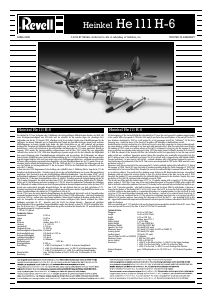

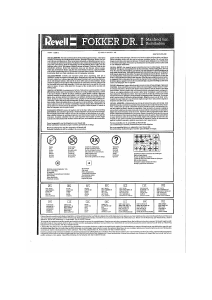
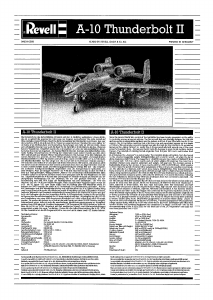
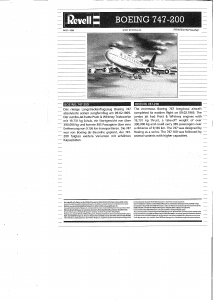
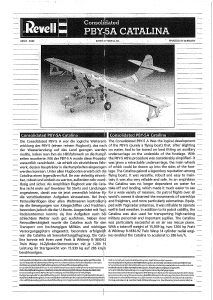
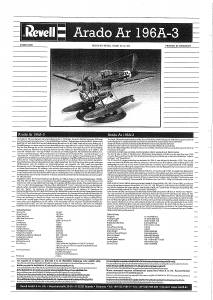

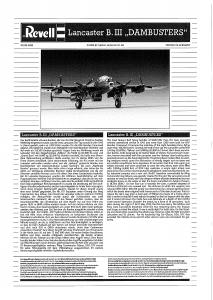
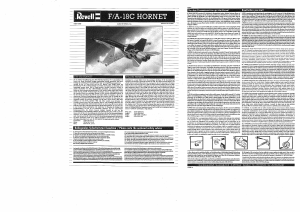
Partecipa alla conversazione su questo prodotto
Qui puoi condividere cosa pensi di Revell set 04836 Airplanes Heinkel He 111 H-6. Se hai una domanda, leggi prima attentamente il manuale. La richiesta di un manuale può essere effettuata utilizzando il nostro modulo di contatto.